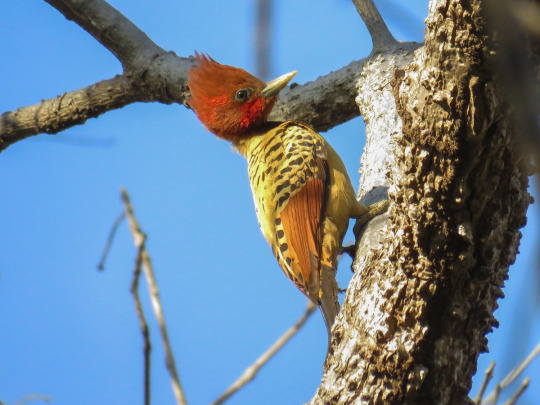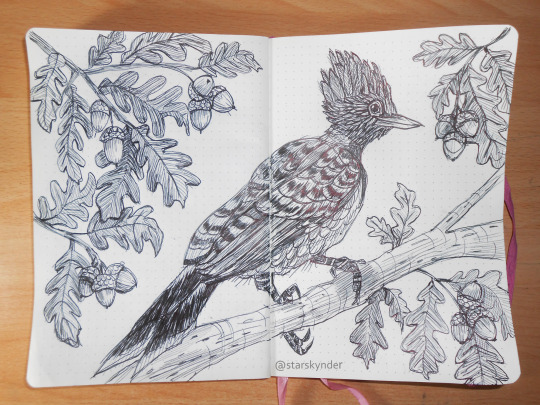#kaempfer's woodpecker
Text
Animal of the Day!
Kaempfer’s Woodpecker (Celeus obrieni)

Photo by Alex Mesquita)
Conservation Status- Vulnerable
Habitat- Brazil
Size (Weight/Length)- 24 cm
Diet- Insects
Cool Facts- Discovered in 1926, the Kaempfer’s woodpecker was thought to have gone extinct only months after the fact as no more were spotted. Amazingly enough, these large woodpeckers were rediscovered in 2006 with many sightings afterwards. It goes to show how easily animals can remain hidden in thousands of miles of rainforest. They eat ants almost exclusively, drilling into bamboo to find ant nests. The conservation status of the Kaempfer’s woodpecker has been argued over for years. Jumping from critically endangered to endangered to vulnerable in only a few years despite their population being in decline. Only 3% of their original habitat remains, the rest being transformed into plantations and livestock pastures.
Rating- 11/10 (Rocking a mohawk.)
#animal of the day#animals#birds#woodpeckers#saturday#january 6#kaempfer's woodpecker#biology#science#conservation#the more you know
84 notes
·
View notes
Text

Kaempfer's Woodpecker (only pen, no pencil) #sketchtember
#Kaempfer's Woodpecker#woodpecker#birds#birbs#sketchtember#sketch#illustration#artists on tumblr#animals#art#artwork#drawing#sketchbook#sketchtember 2023#oak#ballpointpen#ink
25 notes
·
View notes
Video
youtube
From American Bird Conservancy Bird of the Week; February 2, 2018:
Hairy Woodpecker
SCIENTIFIC NAME: Picoides villosus
POPULATION: 8.5 million
TREND: Decreasing
HABITAT: Mature deciduous and coniferous forests
The Hairy Woodpecker gets its name from the long, thread-like white feathers that run down the middle of its black back. This species looks very much like its closely related cousin, the Downy Woodpecker, but has a heftier bill. It's also larger, measuring 9 to 10 inches in length — about the same size as Brazil's rare Kaempfer's Woodpecker.

Ornithologist Arthur Cleveland Bent noted in his Life Histories of North American Birds (published 1919-1968), "The Hairy Woodpecker is a much shier, more retiring bird than the confiding little downy; it is also more active and noisier; it usually will not allow such close approach but will dodge around the trunk of a tree or fly away, if an intruder comes too near, bounding through the air in a series of graceful dips and rebounds."
As befits its bigger size, the Hairy Woodpecker favors more extensive woods with larger trees; this species may even visit well-wooded suburban backyards and parks. This woodpecker can often be located by its explosive “peek” call — incongruously, a higher-pitched call than that of the smaller Downy Woodpecker.
Hairy Woodpecker populations are declining as a result of habitat loss, particularly of older forests. Like Eastern Bluebird, it competes with introduced species such as European Starling for nest holes.
Drumming Up a Mate
The Hairy Woodpecker is one of the most geographically variable bird species in North America, with 17 subspecies currently recognized. These subspecies show regional differences in coloration, patterning, and size.
Male and female Hairy Woodpeckers look almost exactly alike, but (as with the Downy) the male signals its gender with a red patch on the back of its head. Since woodpeckers don't sing to attract mates, they use non-vocal means such as drumming to attract potential partners and lay claim to territories.
Noted ornithologist Edward Howe Forbush described this noisy courtship perfectly in 1927:
"On bright March days this bird begins to practice what is either a love song, a challenge, a call to its mate, or all combined. This is no vocal music but instead a loud drumming on some resonant dead tree, branch, or pole. This long roll or tattoo is louder than that of the Downy Woodpecker, not quite so long, and with a slightly greater interval between each succeeding stroke. It takes a practiced ear, however, to distinguish between the drumming of these two species."
Hairy Woodpeckers are cavity nesters, like Brazil's tiny Tawny Piculet and the rest of the woodpecker tribe. Both sexes excavate the nesting cavity, incubate the clutch of three to six eggs, and feed the young.

Juvenile Hairy Woodpecker by Steve Byland, Shutterstock
Avian Lumberjacks
From the Red-headed to the Blond-crested, woodpeckers are expert climbers. The Hairy is no exception, with strong feet and claws that allow it to cling to tree trunks and branches in almost any position.
Specialized stiff tail feathers act as a prop while the bird hammers away at trees in search of insects, which make up more than 75 percent of its diet. This species especially favors wood-boring insects and their larvae and is often found in areas infested with bark beetles.
The rest of the Hairy Woodpecker's diet is made up of fruits, seeds, and nuts; it has even been seen drinking sap from wells made in the bark by sapsuckers (such as Williamson's Sapsucker). Hairy Woodpeckers have even been known to follow Pileated Woodpeckers, taking insects that the larger birds excavated and missed.
Conserving Hairy Woodpecker Habitat
Although the Hairy Woodpecker is relatively common and widespread, it is threatened by forest loss, particularly of mature forests with larger trees.
ABC works with a wide variety of partners in forested landscapes across the United States, ranging from Appalachia to the Pacific Northwest. Our projects help sustain and conserve habitat used by Hairy Woodpecker and many other bird species, from Cerulean Warbler to Flammulated Owl.
3 notes
·
View notes
Photo

Birds Kaempfer's Woodpecker (Celeus obrieni) endemic to Brazil by Ciro Albano. This woodpecker was last seen in 1926 and feared extinct until a male was captured during mist netting in 2006.
0 notes
Photo

Day 9 - Kaempfer’s Woodpecker with your non guiding hand.
Urgh. This is just awfull :/
0 notes
Photo

Rarity of Brazilian Bamboo: Kaempfer's Woodpecker
Once feared extinct, the Kaempfer’s Woodpecker (Celeus obrieni) was rediscovered in 2006, 80 years after its initial discovery. Long considered a subspecies of the Rufous-headed Woodpecker, the Kaempfer’s was recognized as a distinct species in 2003 based on differences in habitat, size, and plumage, combined with a large distance between the species’ ranges. (Read about another “rediscovered” species that ABC is working to protect, the Palkachupa Cotinga.)
Kaempfer’s Woodpecker is strongly associated with Gadua bamboo and specializes in feeding on ants found inside the bamboo canes. Students at Brazil’s University of Tocatins have been studying this species for several years, increasing knowledge of its range, which is vast but increasingly fragmented by agricultural activities, infrastructure development, and land-clearing for cattle ranching.
This woodpecker does not occur in any protected areas, and there appears to be no clear stronghold site for the species, which puts it at even greater risk of extinction. ABC is working with FAPTO (Fundação de Apoio Científico e Tecnológico do Tocantins) at the University of Tocatins to educate landowners about Kaempfer's Woodpecker and to create private protected reserves for this striking species.
“Trying to find this species requires long drives to remaining forest patches,” says Bennett Hennessey, Brazil Program Coordinator at ABC. “You search within a small bit of forest for a kiddy-pool-sized spot of Gadua bamboo that might be able to maintain a Kaempfer’s Woodpecker.”
Because of the rarity of the species, such searches are not easy. On one visit, Bennett and colleagues from the University of Tocatins spent a day visiting more than seven potential sites but found no woodpeckers. Finally, Bennett says, “We were lucky to find a single bird revisiting drilled holes in the bamboo for its ant food.”
See Kaempfer’s Woodpecker in action in this video by ABC friend Ciro Albano.
(via American Bird Conservancy)
#conservation#endangered#birds#Kaempfer's Woodpecker#Celeus obrieni#Celeus#Picini#Picinae#Picidae#Pici#Piciformes#Aves#woodpecker#Brazil#South America
39 notes
·
View notes